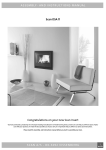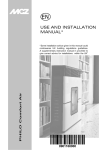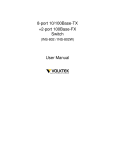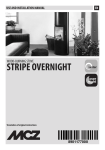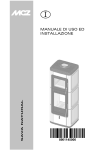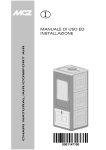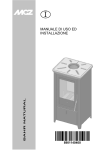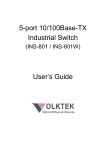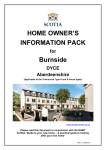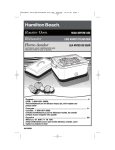Download USE AND INSTALLATION MANUAL
Transcript
EN USE AND INSTALLATION MANUAL 8901145400 USE AND MAINTENANCE MANUAL Contents page 2 INTRODUCTION ....................................................................................................................................3 Document revisions ...............................................................................................................................3 Manual care ..........................................................................................................................................3 How to consult the manual.....................................................................................................................3 1. WARNINGS AND GUARANTEE TERMS...............................................................................................4 1.1. GENERAL SAFETY WARNINGS..........................................................................................................4 1.2. OPERATIONAL WARNINGS ..............................................................................................................4 1.3. GUARANTEE TERMS........................................................................................................................5 1.3.1. Guarantee limits.......................................................................................................................5 1.3.2. Exclusions................................................................................................................................5 1.4. IMPORTANT INFORMATION FOR CORRECT DISPOSAL OF THE PRODUCT IN ACCORDANCE WITH EC DIRECTIVE 2002/96/EC .............................................................................................................................5 2. INSTALLATION RECOMMENDATIONS IN COMPLIANCE WITH UNI 10683 ......................................6 2.1. THE OPERATING ENVIRONMENT .....................................................................................................6 2.2. THE OPERATING ENVIRONMENT .....................................................................................................7 2.2.1. Safe distances..........................................................................................................................7 2.3. CONNECTING THE COMBUSTION AIR INLET PIPE .............................................................................8 2.4. EXTERNAL AIR INLET......................................................................................................................8 2.5. FLUE PIPE CONNECTION...............................................................................................................10 2.6. FLUE PIPE ....................................................................................................................................10 2.6.1. Flue pipe examples.................................................................................................................11 2.7. CHIMNEY .....................................................................................................................................12 3. DIMENSIONS AND TECHNICAL SPECIFICATIONS..........................................................................13 3.1. SAVA STOVE ................................................................................................................................13 3.1.1. Technical specifications...........................................................................................................14 4. INSTALLATION AND ASSEMBLY .....................................................................................................15 4.1. 4.2. 4.3. PREPARATION AND UNPACKING ....................................................................................................15 FOOT ASSEMBLY AND ADJUSTMENT ..............................................................................................16 CERAMIC CLADDING ASSEMBLY ....................................................................................................16 5. OPERATION.....................................................................................................................................18 5.1. WARNINGS PRIOR TO START-UP ...................................................................................................18 5.2. FUEL............................................................................................................................................18 5.3. USING THE STOVE .......................................................................................................................19 5.3.1. FUEL LOADING ......................................................................................................................19 5.3.2. COMBUSTION CONTROL.........................................................................................................19 5.3.2.1. SAVA stove air control......................................................................................................20 5.3.3. FIRST START-UP....................................................................................................................21 5.4. AIR DIFFUSION SYSTEMS .............................................................................................................22 5.4.1. Natural ..................................................................................................................................22 6. MAINTENANCE AND CLEANING ......................................................................................................23 6.1. CLEANING UNDER THE USER'S RESPONSIBILITY ............................................................................23 6.1.1. Cleaning the glazing ...............................................................................................................23 6.1.2. Cleaning the upper Calorite deflectors ......................................................................................23 6.1.3. Ash removal...........................................................................................................................23 6.1.4. Cleaning stainless and matt steel surfaces ................................................................................23 6.1.5. Cleaning painted parts ............................................................................................................24 6.1.6. Cleaning the flue pipe .............................................................................................................24 6.2. CLEANING UNDER THE RESPONSIBILITY OF SPECIALISED STAFF ....................................................24 6.3. QUICK RESPONSE.........................................................................................................................24 Contents Technical dept. - All rights reserved by MCZ GROUP S.p.A. - Reproduction prohibited Introduction USE AND MAINTENANCE MANUAL INTRODUCTION Products built with OYSTER technology, where appropriately installed, due to their fully watertight structure, do not draw on the oxygen inside the room. Instead, they draw air from the outside environment and can therefore be fitted in all well-insulated homes and in passive houses. This technology eliminates all risk of smoke being released into the room and ventilation grilles are no longer required. Consequently, there will be no more flows of cold air into the room, making it less comfortable and compromising the overall efficiency of the system. In the case of forced ventilation or rooms that may be in a negative vacuum compared to the outside, a sealed stove can be installed. To allow optimal operation of the stove and to benefit fully from the heat and sense of wellbeing distributed throughout your home, we advise you to read this manual carefully before starting it up for the first time; in the event of faults or if in doubt, please contact your retailer, who will provide all the necessary assistance. “Italic text” is used to invite the user to observe the explanatory figures beside it or to check other sections in the manual which may provide an additional explanation. NOTE: the “NOTE” provides the reader with additional information about the topic. These symbols indicate found in this manual specific messages CAUTION! This warning symbol indicates you should read carefully and understand the message it refers to since failure to observe the instructions given could damage the stove seriously and also endanger the person using it. INFORMATION: This symbol is used to highlight the information that is deemed important for the correct functioning of the stove. Failure to observe the instructions provided will jeopardise the use of the appliance, the functioning of which may prove unsatisfactory Document revisions In order to improve the product and to update this document, the Manufacturer reserves the right to make any changes without notice. All reproduction, including partial, of this manual is strictly prohibited without the Manufacturer's authorisation. Manual care Take care of this manual and keep it in an easily and rapidly accessible place. Should you misplace or destroy the manual or should it be damaged irreparably, ask your retailer or the Manufacturer for another copy, specifying the product identification data. How to consult the manual Any vital topics or those requiring special attention are printed in “bold text”. Introduction 3 Dear customer, Thank you for purchasing this MCZ appliance. We are convinced that, as you operate it, you will appreciate the high quality of this appliance, which is the result of painstaking design and thorough testing. Our aim is to combine technology with simple use and, first and foremost, safety. page Technical dept. - All rights reserved by MCZ GROUP S.p.A. - Reproduction prohibited USE AND MAINTENANCE MANUAL 1. WARNINGS AND GUARANTEE TERMS 1.1. GENERAL SAFETY WARNINGS Installation, electrical connection, functional check and maintenance of this device must only be performed by qualified or authorised personnel. Install the stove in accordance with all the local and national laws, and the applicable European Standards in force in the place, region or country of installation. This appliance must not be used by anyone (including children) with limited physical, sensory or mental skills or with little experience and knowledge, unless they are supervised or have been instructed to use the device by the person in charge of its safety. Only use the fuel recommended by MCZ. The appliance must not be used as an incinerator. The use of liquid fuel is strictly forbidden. Chapter 1 page 4 communicating rooms, the concurrent use of which causes a vacuum in one of the two rooms. All liability for the incorrect use of the product lies fully with the user and relieves MCZ of any civil and criminal liability. All unauthorised tampering or replacement with non-original stove spare parts could endanger the operator and relieves MCZ of any civil and criminal liability. Parts of the surface of the stove can get very hot (door, handle, glass, smoke outlet pipe, etc.). Please therefore avoid coming into contact with these parts without wearing suitable protective clothing or using appropriate measures, such as heat protective gloves. Incorrect installation or poor maintenance (not conforming to the instructions provided herein) could cause personal injury or harm animals or cause property damage. In this case, MCZ is relieved of any civil and criminal liability. 1.2. OPERATIONAL WARNINGS Use the appliance in accordance with all the local and national laws, and the applicable European Standards in force in the place, region or country of use. The instructions provided in this manual must always be observed to ensure the correct use of this stove and of any appliances connected to it as well as to avoid any accidents. The user - or whoever is operating the stove must read and fully understand the contents of this instruction manual before beginning any operation. Turn off the stove in the event of a failure or malfunctioning. The stove must only be used for its intended use. Any other use is to be considered incorrect and therefore dangerous. Install the stove in premises which are suitably protected against fire hazards and equipped with all the utilities such as supplies (air and electricity) and smoke exhaust. Do not use volatile and/or flammable substances (petrol-alcohol-etc.) to ignite the fire. Do not use the stove as a ladder or supporting structure. Do not place laundry in the stove to dry; any clothes airers or similar items should be kept at a safe distance from the stove. Fire hazard. Assess the static conditions of the surface on which the weight of the stove will bear and provide suitable insulation if it is made of flammable material (e.g. wood, fitted carpet, plastic). Avoid installing the appliance in rooms containing type B gas appliances, or hoods with or without an extractor fan, heat pumps, or collective ventilation ducts (If Oyster technology is not implemented). Avoid having several operational flue ducts in the room, or the proximity of a stair well and make sure that there are no appliances in adjacent Warnings and guarantee terms INFORMATION: Please contact your retailer or MCZ's qualified authorised personnel for any issues, and in the event of repairs, demand original spare parts. Check and clean the smoke outlet pipe regularly in accordance with the provisions of the applicable regulations in the country of installation Keep this instruction manual in a safe place, as it should accompany the stove along its entire life cycle. If the stove is sold or transferred to another user, always ensure that the manual accompanies the appliance. Technical dept. - All rights reserved by MCZ GROUP S.p.A. - Reproduction prohibited Chapter 1 USE AND MAINTENANCE MANUAL 1.3. GUARANTEE TERMS MCZ guarantees the product, with the exception of parts subject to normal wear specified below, for two years from the date of purchase, provided that proof of purchase is supplied in a document specifying the name of the retailer and the date the sale was made and that the completed guarantee certificate was sent within 8 days of said purchase. The product must also be installed and tested by a specialised fitter and in accordance with the detailed instructions provided in the instruction manual that accompanies the product. The guarantee covers the replacement or free repair of parts recognised as being faulty at source due to manufacturing defects. 1.3.1. Guarantee limits The guarantee does not cover parts subject to normal wear, such as: seals, glazing, and all the removable parts of the combustion chamber. The parts replaced will be guaranteed for the remaining guarantee cover period starting from the original date of purchase of the product. The glazing in particular is guaranteed until an authorised MCZ fitter certifies that it is perfectly intact at the time of completion of installation. 1.3.2. Exclusions The guarantee does not cover all parts found to be faulty due to negligence or inappropriate use, incorrect maintenance, or installation not performed in compliance with MCZ's instructions (see relevant chapters in this use manual). MCZ will not be held liable for any damage which may - either directly or indirectly - be caused to property, or personal injury or harm to animals ensuing from failure to observe all the instructions provided herein and specifically concerning the warnings regarding installation, use and maintenance of the device. page The guarantee is not valid for damage caused by tampering with the device, atmospheric agents, natural disasters, electrical discharges, fires, faults in the electrical and plumbing system and caused by failure to perform maintenance or by incorrect maintenance in compliance with the Manufacturer's instructions. Service call Service calls must be made to the retailer, who will forward the call to the MCZ technical support department. MCZ cannot be held liable if the product and any of its accessories are used incorrectly or modified without authorisation. Only original MCZ spare parts must be used for replacements. 1.4. IMPORTANT INFORMATION FOR CORRECT DISPOSAL OF THE PRODUCT IN ACCORDANCE WITH EC DIRECTIVE 2002/96/EC . At the end of its working life, the product must not be disposed of as urban waste. It must be taken to a special local authority differentiated waste collection centre or to a dealer providing this service. Disposing of a appliance separately avoids possible negative consequences for the environment and health deriving from inappropriate disposal and enables the constituent materials to be recovered to obtain significant savings in energy and resources. As a reminder of the need to dispose of appliances separately, the product is marked with a crossed-out wheeled dustbin. Please contact your retailer and/or local importer in the event of product failure. Damage caused by transport and/or handling are not covered by the guarantee. Reference must be made solely to the manual provided for product installation and use. Warnings and guarantee terms 5 Technical dept. - All rights reserved by MCZ GROUP S.p.A. - Reproduction prohibited USE AND MAINTENANCE MANUAL Chapter 2 page 6 2. INSTALLATION RECOMMENDATIONS IN COMPLIANCE WITH UNI 10683 2.1. THE OPERATING ENVIRONMENT For the correct functioning and an even distribution of heat, the stove should be positioned where the air required for combustion is accessible (at least 60 m3/h must be available) in accordance with the installation instructions and the applicable standards in force in the country of installation. The volume of the room should be no less than 60 m3. The air should enter through permanent apertures made in the walls (near the stove) onto the outside with a minimum cross-section of 150 cm2 (in the case of non-Oyster installation). These apertures (air inlets) must be made in such a way as not to obstruct them in any way. Air may also be taken from adjoining rooms to the one to be ventilated, provided they are equipped with an external air inlet and that they are not used as a bedroom or bathroom or where there is no fire hazard, such as: garages, timber storerooms, warehouses of flammable materials, observing under all circumstances the provisions of all the applicable standards in force. If the floor is wood, lay the floor guard down, in compliance with the applicable standards in force in the country of installation. If the walls are not flammable, position the stove with a minimum rear clearance of at least 10 cm. Extreme proximity between the stove and the wall could cause overheating and damage the plaster (yellowing, cracking, etc..) Stove installation and assembly performed by qualified staff. The stove must be connected to a flue pipe or a vertical duct that can discharge the smoke at the highest point of the home. The stove must be connected to a flue pipe or internal or external vertical duct, in accordance with the applicable standards in force. The smoke does however result from combustion of wood essences, and may therefore soil walls if released in contact with or close to the latter. Before positioning the stove, drill the hole for the external air inlet (not in the case of installation with Oyster technology). Installation recommendations in compliance with UNI 10683 must be Technical dept. - All rights reserved by MCZ GROUP S.p.A. - Reproduction prohibited USE AND MAINTENANCE MANUAL 2.2. Chapter 2 page 7 THE OPERATING ENVIRONMENT In the case of concurrent installation with other heating appliances, provide the appropriate air inlets for each one (according to the instructions for each appliance). Installing the stove in a bedroom or bathroom is not permitted, nor in any room where another heating appliance is installed without an independent air inflow. It is forbidden to position the stove in rooms with an explosive atmosphere. The floor of the room where the stove is installed must be suitably sized to withstand its weight. SAVA Safe distances Non-flammable walls * Flammable walls * A=15cm B=20cm A=20cm B=30cm 20 cm min. 2.2.1. A 30 B cm. * Leave an appropriate distance from the walls in any case in order to allow easier appliance maintenance. If particularly delicate objects are present, such as furniture, curtains or sofas, increase the stove clearances substantially. If the stove is positioned on a flammable floor, we recommend you ensure it is suitably insulated. Heat-sensitive or flammable objects and parts cannot be stored near the stove; keep such objects or parts at a minimum front clearance of 100 cm from the outermost point of the appliance. Installation recommendations in compliance with UNI 10683 Technical dept. - All rights reserved by MCZ GROUP S.p.A. - Reproduction prohibited Chapter 2 USE AND MAINTENANCE MANUAL page 2.3. CONNECTING THE COMBUSTION AIR INLET PIPE The combustion air outlet does not necessarily have to be connected to the outside; only if you wish to use Oyster technology do you need to connect the combustion air inlet to the outside of the home. Always use pipes and unions with appropriate seals that guarantee air- and watertightness. Products built with Oyster technology, due to their fully watertight structure, do not draw on the oxygen inside the room. Instead, they draw air from the outside environment and can therefore be fitted in all well-insulated homes and in passive houses. In order to satisfy these requirements, the 80 mm diameter connection pipe for the combustion air inlet must be connected to the outside of the building. The air inlet should also: be designed with a grille, insect-proof metal mesh or suitable protection, provided it does not reduce the minimum crosssection. be positioned in such a way as to not be obstructed the maximum length permitted for ducting is 6 m, with two 90° elbows Rear view of the Sava stove: 1) Combustion air inlet The stove must be connected to the external air inlet using pipes and unions which guarantee watertightness to comply with the requirements of the sealed stove (OYSTER technology). 2.4. EXTERNAL AIR INLET It is necessary for the room in which the stove is installed to provide at least as much air as is required for regular combustion (not in the case of installation with Oyster technology). This can be achieved through permanent apertures made in the walls of the room to be ventilated onto the outside or rooms aired in accordance with UNI 10683 REV. To this end, drill a through hole in the external wall near the stove with a minimum free cross-section of 150 cm². (15 cm diameter or 10x15 cm rectangular hole), protected by a grille on the inside and on the outside. The air inlet should also: communicate directly with the installation setting be designed with a grille, insect-proof metal mesh or suitable protection, provided it does not reduce the minimum crosssection. be positioned in such a way as to not be obstructed Installation recommendations in compliance with UNI 10683 Technical dept. - All rights reserved by MCZ GROUP S.p.A. - Reproduction prohibited 8 USE AND MAINTENANCE MANUAL Chapter 2 page in the case of ducting, up to 3.5 linear metres, increase the cross-section by about 5% whereas for longer ducter, increase it by 15%. Remember that the ventilation grilles always feature an indication of the useful cross-section in cm2 on one side. When choosing the grille and hole size, check that the useful cross-section of the grille is larger or the same as the crosssection required by MCZ for the appliance operation. IMPORTANT! The flow of air may also be taken from an adjoining room to the one in which the stove is installed, provided the air can flow freely through permanent apertures communicating with the outside; avoid air inlets connected to thermal power plants, garages, kitchens or bathrooms. Installation recommendations in compliance with UNI 10683 Technical dept. - All rights reserved by MCZ GROUP S.p.A. - Reproduction prohibited 9 Chapter 2 USE AND MAINTENANCE MANUAL 2.5. page 10 FLUE PIPE CONNECTION The flue pipe connection is extremely important, and it should be performed carefully and attentively. Stoves have a top or rear smoke outlet. The smoke outlet pipe must be fitted in such a way as to guarantee its seal during the appliance's vacuum operation and avoid the formation and conveying towards the stove of any condensation. MAX 2 mt. 3-5% Any manual draught control devices inserted in the pipe should not hermetically seal the internal section of the duct. These shutters should be equipped with a suitable mechanism to avoid the complete rotation of the valve in the closed position. The minimum safety opening surface must be 3% of the through cross-section, and not less than 10 cm². If the smoke duct has a horizontal section, the same should rise with a minimum slope gradient of 3-5% (3-5 cm for every metre). The tilted horizontal part should not be longer than 2 linear metres. Flue pipe connection example The use of flexible pipes and fibre cement pipes is forbidden. The smoke pipe must not cross rooms in which it is forbidden to install combustion appliances. The use of counter-sloping pipes is forbidden. 2.6. Chimney FLUE PIPE The flue pipe is vital for the disposal of smoke and should therefore comply with the following requisites: Be waterproof and thermally insulated. Be made of suitable heat-proof materials, resistant to the effects of the combustion products and any possible condensation. Have a prevalently vertical arrangement with deviations from the axis of no more than 45° and without kinks. must be suitable for the specific operating conditions of the product and marked EC (EN1856-1, EN1443). must be suitably sized to accommodate the draught/smoke disposal requirements necessary for the correct functioning of the product (EN13384-1). Have an internal section which is preferably circular. If it is existing and has operated beforehand, it should be cleaned. The flue pipe is vital for the correct functioning and safety of your stove. Installation recommendations in compliance with UNI 10683 Flue pipe Smoke union External air inlet Typical diagram of a correctly laid flue pipe with, at the foot of the external rising section, the positioning of a chamber with a sealed hatch to collect and remove the solid materials produced during combustion. Technical dept. - All rights reserved by MCZ GROUP S.p.A. - Reproduction prohibited Chapter 2 USE AND MAINTENANCE MANUAL 2.6.1. page 11 Flue pipe examples AISI 316 steel flue pipe with double chamber insulated with fibreglass or similar, resistant to 400 °C. EXCELLENT Refractory flue pipe with double insulated chamber and external concrete jacket lightened with honeycomb material such as clay. Traditional square-section clay flue pipe with empty insulating inserts. MEDIOCRE GOOD Avoid flue pipes with rectangular cross-sections where the larger side is twice the smaller one, such as 20x40 or 15x30. POOR For square- or rectangular-section flue pipes, the internal corners should be rounded with a radius of no less than 20 mm. For the rectangular cross-section, the ratio between the internal dimensions should be ≤1.5. The sections/lengths of the flue pipe shown in the technical data table are guidelines for correct installation. Any alternative configurations must be suitably sized in accordance with EN13384-1. You are advised to fit a chamber to the smoke duct to collect solid materials located beneath the mouth of the smoke duct. This chamber should be easy to open and inspect from the airtight flap. IMPORTANT! If you have doubts about the performance of your flue pipe or if the dimensions of the latter differ from the recommended values, it is highly advisable to have an authorised MCZ fitter perform a prior survey and instrumental measurement of the performance of the flue pipe (measurement with micro pressure gauge) MCZ s.p.a. will not be held liable for any stove malfunctioning if the same is ascribable to the use of a poorly sized flue pipe installed in a way that does not comply with the requisites listed herein. Installation recommendations in compliance with UNI 10683 Technical dept. - All rights reserved by MCZ GROUP S.p.A. - Reproduction prohibited Chapter 2 USE AND MAINTENANCE MANUAL 2.7. page 12 CHIMNEY Often, if it is underestimated, it prevents the correct functioning of the "chimney system". The draught of the flue pipe also depends on its chimney. It is therefore vital that, if it has been hand-crafted, the development of the four relief sections correspond to more than twice the internal cross-section of the flue pipe. Since it should always be higher than the ridge of the roof, the chimney will be exposed to all weather, and so an industrialtype chimney is recommended. The correct outlet cross-section should be at least twice the internal crosssection of the flue pipe, ideally 2.5 times its size. The chimney must: Have an inner section equal to that of the flue. Have a working outlet section of at least double that of the inner section of the flue pipe. Be built in such a ways as to prevent rain, snow and any foreign bodies from penetrating the flue pipe. Be positioned so as to ensure adequate dispersion of smoke and, in all cases, outside the reflux area in which backpressures are likely to form. In the case of paired flue pipes, the solid combustibility or upper storey chimney shall be at least 50 cm higher than the others in order to avoid the transfer of pressure from one paired pipe to the other. Steel flue pipe chimney with internal smokedeflector cone. Allows excellent smoke disposal. UPPER STOREY COMBUSTIBILITY OR SOLID LOWER STOREY 0.5 mt Allows excellent smoke disposal. Traditional handcrafted chimney. , 1 mt Industrial chimney with prefabricated stacked elements. YE The chimney must not have any obstacles within a range of 10 metres, including walls, pitches and trees. If this is the case, then raise it at least 1 metre above the obstacle and in the event of other chimneys nearby, space them at least 2 metres apart and in all cases the chimney must protrude from the ridge of the roof by at least 1 metre. NO Installation recommendations in compliance with UNI 10683 Technical dept. - All rights reserved by MCZ GROUP S.p.A. - Reproduction prohibited Chapter 3 USE AND MAINTENANCE MANUAL page 3. DIMENSIONS AND TECHNICAL SPECIFICATIONS 630 1459 3.1. SAVA STOVE 390 Ø 218 302 78 267,5 Dimensions and technical specifications Ø 146 537 457 192 535 267,5 Technical dept. - All rights reserved by MCZ GROUP S.p.A. - Reproduction prohibited 13 USE AND MAINTENANCE MANUAL 3.1.1. Chapter 3 page Technical specifications Technical specifications Fuel type Sava natural (with oven) Wood - logs Hourly consumption 2.05 Kg/h – 1.4 kg/h Global heat output Max KW 7/Kcal 6020 Global heat output Min: KW 3.5/Kcal 3010 Efficiency 84,7 % 3 Heatable volume m Recommended draught Smoke temperature Particulate 151/40 – 172/35 – 201/30 12 Pa / 0,12 mbar 240 °C 30 mg/Nm3 (13% O2) 17 mg/MJ Smoke outlet Combustion chamber dimensions Net weight Ø 15 cm 33 x 25 - h 43 Kg 220 External combustion air inlet cm² 200 CO emission in the smoke (13% O2) 0,09 % Smoke flow rate 6.9 g/s Flue pipe Flue pipe cross-section Minimum flue pipe height 18x18 cm Ø18 4m Notes The stove is an intermittent combustion appliance * These data may vary according to the type of fuel used Dimensions and technical specifications Technical dept. - All rights reserved by MCZ GROUP S.p.A. - Reproduction prohibited 14 USE AND MAINTENANCE MANUAL Chapter 4 page 4. INSTALLATION AND ASSEMBLY IMPORTANT! The stove must be installed and connected to the flue pipe by a specialised technician or by competent staff so that all local or national regulations are complied with and in all cases in accordance with the provisions of standard UNI 10683 REV. When you unwrap the stove and related frame, make sure that every part is in perfect working order or check for any damage due to transport. If the stove is installed in a difficult to access place, the weight can be lightened by removing the internal elements making up the combustion chamber. We recommend you reposition each element correctly. 4.1. PREPARATION AND UNPACKING The Kasai stove is delivered with three different packagings: one contains the stove (figure 1) one contains the ceramic parts (sides and fronts) figure 2 (the box containing the ceramic parts will be placed on top of the structure packaging) Open the package, remove the packaging straps and the two brackets that secure the stove to the pallet (figure 3). Remove the two screws (A) from the bracket at the bottom right and left of the stove. Then remove the other three screws (B) securing the bracket to the pallet and position the stove in the chosen location, making sure it complies with the applicable provisions. Figure 1 - Sava stove packaging Figure 3 - Removing the packaging screws (Sava stove) A A BRACKE B Figure 2 - Sava stove ceramic packaging B B Installation and assembly Technical dept. - All rights reserved by MCZ GROUP S.p.A. - Reproduction prohibited 15 USE AND MAINTENANCE MANUAL Chapter 4 page The stove must always be handled vertically and only with trolleys. Pay special attention to the door and its glazing, to protect them from mechanical knocks which would compromise their good working order. In all cases, appliances must be handled with care. If possible, unwrap the stove near the chosen place of installation. The materials making up the packaging are neither toxic nor harmful, and so require no particular disposal measures. Storage, disposal or any recycling is under the responsibility of the end user in compliance with the applicable laws in force. 4.2. FOOT ASSEMBLY AND ADJUSTMENT Some models envisage the assembly of support feet, designed to level the stove so that it is aligned and stable on the floor. The feet are screwed into the base of the structure, and they can be installed as illustrated in the figure and adjusted with a screwdriver, inserting it into the tip of the feet. 4.3. CERAMIC CLADDING ASSEMBLY The installation of the ceramic parts does not present any particular difficulties: Ceramic on ash tray: 1. Remove lever “A” as follows: remove the black cap at the top of the lever “O”, you will find a screw “P” inside it; loosen it and remove the lever “A”. 2. Remove the brackets “B”, insert the ceramic part “D” onto the hook of air adjustment lever “A” and screw the brackets “B” back on to secure the ceramic in place. Ceramic on front panel “E”: 1. Loosen the two brackets “C” (left and right) and insert the ceramic front panel “E” from the top down. You can now fit the ceramic sides on: 1. Take the side “F” fitting the pins featured on the side into the corresponding slots featured at the bottom of the stove structure. At the top of the ceramic panel, secure the side to the structure using two screws. Repeat the same steps with the side G, H and with sides I-L-M. Ceramic top assembly: 1. Rest the cover “N” onto the purpose-provided rubber pads featured on the stove casing. Installation and assembly Technical dept. - All rights reserved by MCZ GROUP S.p.A. - Reproduction prohibited 16 Chapter 4 USE AND MAINTENANCE MANUAL page 17 N M C C H E L G I F B B D P SPINE PINS A O Installation and assembly Technical dept. - All rights reserved by MCZ GROUP S.p.A. - Reproduction prohibited USE AND MAINTENANCE MANUAL Chapter 5 page 5. OPERATION 5.1. WARNINGS PRIOR TO START-UP Make sure you have read and fully understood the contents of this instruction manual. Remove all components which could burn from the stove and door (instructions and various adhesive labels). Remove the stickers from the glass ceramic otherwise the high temperature could melt them and cause irreparable damage to the glass. If this is the case, MCZ will not guarantee the glass. The stove can be positioned either in a corner or up against a wall. Avoid touching the stove during the initial start-up, since the paint completes its drying process during this time and hardens. It is good practice to guarantee the efficient ventilation in the room during the initial start-up, since the stove will release some smoke and paint smells. If necessary, touch up the paint with the spray can of the dedicated colour. (see "Stove accessories”) Do not stand close to the stove and as mentioned, air the room. The smoke and paint smell will disappear after about an hour of operation, but remember that they are not in any case harmful. The stove will undergo expansion and contraction during the start-up and cooling phases, so it may squeak slightly. This is completely normal, since the structure is made of laminated steel and should therefore not be considered a defect. It is extremely important to make sure you do not immediately overheat the stove, but instead raise the temperature gradually. This will avoid any damage to the welding and to the steel structure. Do not try to achieve the maximum heating efficiency immediately! 5.2. FUEL FUEL: Wood In order to get the best efficiency from your stove, it is of vital importance that you use wood with appropriate characteristics. Heating wood can be used, such as oak-beech-ash-robinia or nonresinated pressed logs. The latter have a high calorific value and Operation Technical dept. - All rights reserved by MCZ GROUP S.p.A. - Reproduction prohibited 18 Chapter 5 USE AND MAINTENANCE MANUAL page 19 must be used with caution to avoid harmful overheating of the stove. Fuels such as poplar-pine-linden-chestnut have a low calorific value as the wood is soft, i.e. tender, and does not last long. The humidity content is fundamental for all types of wood. A high percentage humidity causes condensation to form in the smoke duct, causing an alteration to the draught and generating smoke and considerable soot deposits in the combustion chamber, on the door glazing and on the flue pipe, with the subsequent possible fire hazard in the same; in addition, it leads to a much lower global efficiency. The use of humid or treated wood releases a larger than normal quantity of smoke, which could soil the glass more quickly. The poor performance of the flue pipe can also compromise the cleanliness of the glass, considering that the smoke remains in the combustion chamber longer than usual. Calorific value Wood drying time (e.g. beech) % humidity Freshly cut 50 / 3 Months 40 2410 6 Months 35 2700 9 Months 30 2900 12 Months 25 3150 15 Months 20 3400 18 Months 15 3710 21 Months 10 3980 Kcal/h Do not use treated fuels (painted or lacquered wood) or non-compliant fuels (plastic or derivatives) which could release toxic substances or pollutants. Do not burn waste. The gases produced by combustion resulting from the use of unsuitable fuel could damage the stove, the flue pipe, pollute and compromise your health. 5.3. 5.3.1. USING THE STOVE FUEL LOADING To load the fuel, simply open the door by lifting the handle and pulling the door towards you. During use, the metal parts and the glazing reach very high temperatures, so it is necessary to use a heat protective glove (not included). During combustion, the door to the combustion chamber must remain closed. It is forbidden to load larger quantities of fuel than those specified in the technical datasheets of each individual product. Excessive quantities of fuel introduced into the combustion chamber could damage and warp the combustion chamber and the structure of the stove. MCZ will not be held liable for any damage caused by fuel overloads or by the use of fuels which do not comply with the specifications. 5.3.2. COMBUSTION CONTROL The combustion and therefore the combustion air inlet is controlled via a single control lever. The inlet air is either: Operation Technical dept. - All rights reserved by MCZ GROUP S.p.A. - Reproduction prohibited Chapter 5 USE AND MAINTENANCE MANUAL page 20 PRIMARY AIR: Primary air is introduced at the base of the flame to encourage mostly the stove start-up operation SECONDARY AIR: The introduction of secondary air is predetermined, and is used for the partial cleaning of the glass and allows the completion of the combustion process. Consequently, if it is well calibrated, the efficiency and heating performance of the stove are higher. 5.3.2.1. SAVA stove air control Move the control lever towards the right if you want more combustion air to enter the combustion chamber. Vice versa move the lever towards the left if your want less air inlet. The primary and secondary air inlet is predetermined; move the lever to dose the quantity of primary and secondary inlet air. 1 3 2 Fig.4 Primary air inlet Fig.5 Secondary air inlet Fig.6 Minimum primary air inlet Start-up PRIMARY AIR LEVER (TURNED TOWARDS THE RIGHT) The lever turned towards the right (pos.1) is designed to bring a large quantity of primary air beneath the combustion chamber fire plane, to allow rapid and effective ignition of the fire (Fig.4). SECONDARY AIR LEVER (TURNED DOWN) Secondary air, as mentioned above, allows the completion of combustion and increases the efficiency (lever in pos.2 - fig.5). The position of the lever in fig.5 determines the nominal output, minimizing primary air and the secondary air inlet. LEVER TURNED TOWARDS THE LEFT From this point, turn the lever clockwise to decrease the quantity of air in the combustion chamber until position 3 is reached, where only a minimum quantity of primary air is present (fig.6). This position is used to prolong combustion (for instance, at night, or when you are not at home) so that the stove is set to minimum for auto-combustion, to save on fuel and keep the flame burning. Operation Technical dept. - All rights reserved by MCZ GROUP S.p.A. - Reproduction prohibited USE AND MAINTENANCE MANUAL 5.3.3. Chapter 5 page FIRST START-UP We recommend that the first start-up be performed with caution, using fine and seasoned wood. The combustion air inlet must be completely open. When combustion has started up, normal sized wood can be introduced. The flame must be as laminar as possible. During the various reloading processes, the fire door must be opened slowly to avoid smoke being released into the room. Proceed as follows: Place a small ball of scrunched up paper into the stove. Cover the paper with a small quantity of twigs and a few pieces of wood. Open the combustion air damper completely (right-hand lever). Light the paper and if necessary keep the door open a few minutes until the combustion chamber and the flue pipe begin to warm up. Once the twigs have caught alight, you can shut the door. As the fire gradually burns, add wood. In all cases, never overload the stove with wood (see the technical data in the table). As soon as the flames have died down and a bed of embers has formed, load the stove normally. Small loads are preferable to large loads of wood for combustion. We recommend you implement this fuel loading method, also in all subsequent appliance use. To achieve the nominal heat output, introduce the wood load indicated in the technical data table into the combustion chamber (chapter 3). The stove's running time is approximately 45 minutes. On completion of combustion, reload the stove again. Operation Technical dept. - All rights reserved by MCZ GROUP S.p.A. - Reproduction prohibited 21 USE AND MAINTENANCE MANUAL Chapter 5 page Caution! 5.4. Do not use volatile and/or flammable substances (petrol-alcohol-etc.) to ignite the fire. Do not use fuels that could release toxic substances or pollutants. Do not put the fire out by throwing water on it. Check the external-internal air inlet and the flue pipe at least once a year, cleaning them thoroughly. During use, the metal parts and the glazing reach very high temperatures. Use suitable protections when reloading or adjusting the appliance or removing ash. Never leave children unsupervised near the stove when it is operating. There is a very high risk of scalding due to contact with hot parts. In the event of poor weather conditions for the operation of the stove (low pressure, external temperatures not particularly harsh, windy day), this may lead to inverse draught in the flue pipe. If this is the case, we recommend you use a small quantity of paper to heat the flue pipe and restore normal draught. Then proceed with normal stove start-up. AIR DIFFUSION SYSTEMS Heat is transmitted to the rooms in the following system: 1. Natural (standard) 5.4.1. Natural The heat is transmitted in the room via natural convection. The hot air that forms inside the stove is diffused uniformly and naturally in the room. Operation Technical dept. - All rights reserved by MCZ GROUP S.p.A. - Reproduction prohibited 22 USE AND MAINTENANCE MANUAL Chapter 6 page 6. MAINTENANCE AND CLEANING CAUTION! All the cleaning operations of all parts should be performed with the stove completely cold. 6.1. CLEANING RESPONSIBILITY 6.1.1. UNDER THE USER'S Cleaning the glazing To clean the glazing, you may use specific products (see our price list), a cloth dipped in water and ammonia solution or a little white ash and a sheet of newspaper. Any soot build-up and dirt will prolong the glazing cleaning time. CAUTION! Do not spray the cleaner onto the painted parts or onto the seals of the door (ceramic fibre cord) The glass ceramic installed on MCZ products have a heat resistance of approximately 750 °C and are tested and checked prior to and after assembly to check for any cracks, bubbles and swelling. Despite the high resistance to temperatures, the glazing is nonetheless a fragile element and so it is advisable to handle the door carefully without slamming it or forcing it open or shut. Since it is not a flexible element, the glazing may break. In addition, this type of glazing does not shatter or burst and should it break, for the above reasons, only a crack will form. 6.1.2. Cleaning the upper Calorite deflectors They require no special care. After prolonged usage, the efficient yet porous material used to make the internal deflectors of the combustion chamber wears and may get damaged. They will need to be replaced only when their thickness is halved or they break. 6.1.3. Ash removal This task must be performed with the stove turned off; we recommend you clean the ash tray thoroughly to ensure correct combustion. Open the door and remove the ash tray as shown in figure 7. Hot ashes must not be stored outside unsupervised or thrown into the rubbish bin. Allow it to cool in the open air in a metal container. 6.1.4. Cleaning stainless and matt steel surfaces Usually these surfaces do not need any special treatment and avoiding cleaning them with abrasive materials is sufficient. For stainless and matt steel surfaces, we recommend you clean these with a paper towel or a dry, clean cloth dipped in detergent made with non ionic surfactants (<5%); spray glass and mirror cleaner is recommended. Maintenance and cleaning Figure 7 - Ash tray Technical dept. - All rights reserved by MCZ GROUP S.p.A. - Reproduction prohibited 23 USE AND MAINTENANCE MANUAL 6.1.5. Chapter 6 page Cleaning painted parts Avoid cleaning the painted parts when the product is in operation or hot, with damp cloths to avoid the thermal shock of the paint and its consequent detachment. Do not use abrasive or aggressive materials or products. Clean with a paper towel or damp cotton. The silicone paints used to coat MCZ products have top quality technical properties which ensure the resistance to very high temperatures. There is however a physical limit (380°-400°) beyond which the paint loses its characteristics and begins to "whiten" or (above 450°) “vitrifies” and can flake and peel away from the steel surface. If this occurs, it means that temperatures well above those at which the appliance should operate correctly have been reached and consequently we recommend the use of the quantity of fuel specified in the technical tables. 6.1.6. Cleaning the flue pipe We recommend the mechanical cleaning of the flue pipe at least once a year; excess build-up of unburned waste could cause problems with the smoke discharge and start a fire in the flue pipe itself. 6.2. CLEANING UNDER THE RESPONSIBILITY OF SPECIALISED STAFF CAUTION: The frequency with which the stove is to be cleaned should be determined according to its use and the type of installation. MCZ recommends you contact an authorised service centre for the maintenance and cleaning of the entire flue pipe system at the end of the season because in addition to performing the above-mentioned operations, a general check of the appliance will also be performed. 6.3. QUICK RESPONSE If for any reason it is necessary to put out the fire in the stove suddenly and quickly or put out a fire that has started in the flue pipe, respond as follows: If you have time, remove the embers and ash using a metal container. Request urgent assistance from the competent authorities. Maintenance and cleaning Technical dept. - All rights reserved by MCZ GROUP S.p.A. - Reproduction prohibited 24 MCZ GROUP S.p.A. Via La Croce 8 33074 Vigonovo di Fontanafredda (PN) – ITALY Telephone: +39 0434/599599 PBX Fax: +39 0434/599598 Internet: www.mcz.it e-mail: [email protected] 8901145400 Rev 1 12/2011

























